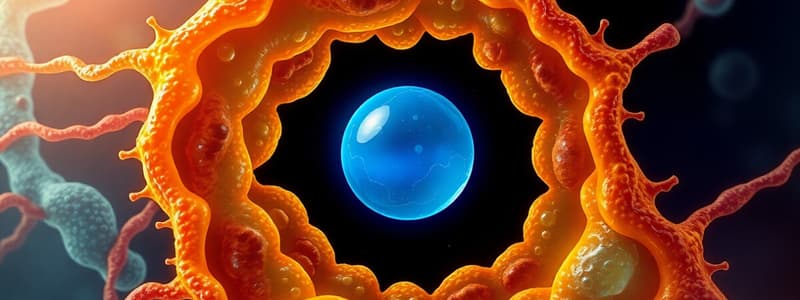Podcast
Questions and Answers
Which organelle is present in plant cells but absent in animal cells?
Which organelle is present in plant cells but absent in animal cells?
- Mitochondria
- Lysosome
- Chloroplast (correct)
- Ribosome
What structure is found in both animal and plant cells?
What structure is found in both animal and plant cells?
- Nucleus (correct)
- Chloroplast
- Centrioles
- Cell wall
Which of the following organelles is only present in animal cells?
Which of the following organelles is only present in animal cells?
- Endoplasmic Reticulum
- Chloroplast
- Ribosome
- Lysosome (correct)
Which part of the cell provides structural support in plant cells but is absent in animal cells?
Which part of the cell provides structural support in plant cells but is absent in animal cells?
Which of the following organelles is responsible for energy production in both plant and animal cells?
Which of the following organelles is responsible for energy production in both plant and animal cells?
The ______ is a selective barrier that surrounds both animal and plant cells.
The ______ is a selective barrier that surrounds both animal and plant cells.
The ______ is present in plant cells but is absent in animal cells, providing additional support.
The ______ is present in plant cells but is absent in animal cells, providing additional support.
The ______ is the control center of the cell that contains genetic material.
The ______ is the control center of the cell that contains genetic material.
Plant cells contain ______ which are responsible for photosynthesis.
Plant cells contain ______ which are responsible for photosynthesis.
The ______ is known as the powerhouse of the cell, providing energy in the form of ATP.
The ______ is known as the powerhouse of the cell, providing energy in the form of ATP.
Animal cells have ______ which are involved in cell division.
Animal cells have ______ which are involved in cell division.
The ______ is involved in the modification and packaging of proteins in both animal and plant cells.
The ______ is involved in the modification and packaging of proteins in both animal and plant cells.
Flashcards are hidden until you start studying
Study Notes
Cell Structure and Functions
- Protoplasm consists of all the cellular components including cell membrane, cytoplasm, and nucleus.
Common Cell Components
- Cell Membrane: Present in both animal and plant cells, it regulates the movement of substances in and out of the cell.
- Cytoplasm: A gel-like substance filling the cell, contains cytosol and organelles.
- Nucleus: Found in both cell types, acts as the control center containing genetic material.
Unique Components
- Cell Wall: Unique to plant cells; provides structure and protection. Absent in animal cells.
- Lysosome: Found only in animal cells; contains digestive enzymes for waste processing.
- Chloroplast: Present only in plant cells; site of photosynthesis converting sunlight into food.
- Centrioles: Found in animal cells, involved in cell division; absent in plant cells.
Common Organelles in Both Cell Types
- Ribosomes: Sites of protein synthesis.
- Endoplasmic Reticulum (ER):
- Rough ER: Studded with ribosomes for protein synthesis.
- Smooth ER: Lacks ribosomes, involved in lipid synthesis and detoxification.
- Golgi Body: Modifies, sorts, and packages proteins and lipids for secretion.
- Mitochondria: Known as the powerhouse of the cell, involved in energy production.
- Vacuole: Storage sac for nutrients, waste, and other materials.
- Cytoskeleton: Provides structural support and aids in cell movement.
Summary of Differences
- Animal Cells:
- No cell wall or chloroplasts.
- Contain lysosomes and centrioles.
- Plant Cells:
- Have a cell wall and chloroplasts.
- Lack lysosomes and centrioles.
Cell Structure and Functions
- Protoplasm consists of all the cellular components including cell membrane, cytoplasm, and nucleus.
Common Cell Components
- Cell Membrane: Present in both animal and plant cells, it regulates the movement of substances in and out of the cell.
- Cytoplasm: A gel-like substance filling the cell, contains cytosol and organelles.
- Nucleus: Found in both cell types, acts as the control center containing genetic material.
Unique Components
- Cell Wall: Unique to plant cells; provides structure and protection. Absent in animal cells.
- Lysosome: Found only in animal cells; contains digestive enzymes for waste processing.
- Chloroplast: Present only in plant cells; site of photosynthesis converting sunlight into food.
- Centrioles: Found in animal cells, involved in cell division; absent in plant cells.
Common Organelles in Both Cell Types
- Ribosomes: Sites of protein synthesis.
- Endoplasmic Reticulum (ER):
- Rough ER: Studded with ribosomes for protein synthesis.
- Smooth ER: Lacks ribosomes, involved in lipid synthesis and detoxification.
- Golgi Body: Modifies, sorts, and packages proteins and lipids for secretion.
- Mitochondria: Known as the powerhouse of the cell, involved in energy production.
- Vacuole: Storage sac for nutrients, waste, and other materials.
- Cytoskeleton: Provides structural support and aids in cell movement.
Summary of Differences
- Animal Cells:
- No cell wall or chloroplasts.
- Contain lysosomes and centrioles.
- Plant Cells:
- Have a cell wall and chloroplasts.
- Lack lysosomes and centrioles.
Studying That Suits You
Use AI to generate personalized quizzes and flashcards to suit your learning preferences.




